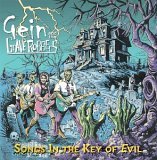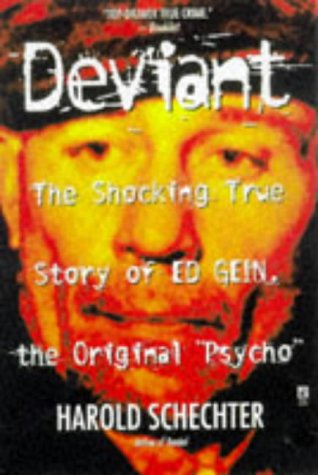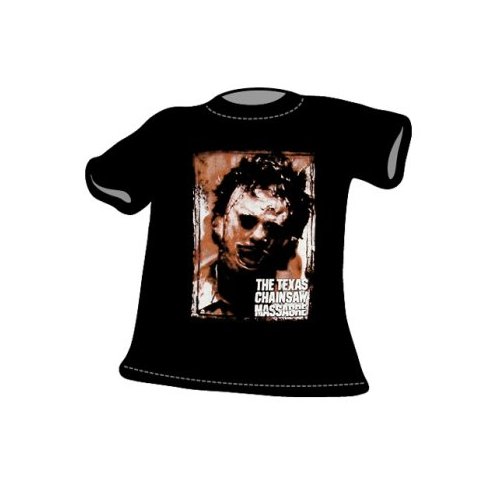| True Crime Book Watch!
Ed Gein: The Butcher of Plainfield, The Mad Butcher, The Plainfield Ghoul Edward Theodore Gein was born on August 27, 1906 in La Crosse, Wisconsin to a pious, Evangelical, extremist, domineering mother, Augusta, and George, his hen pecked, violent, but introverted alcoholic father, who could not keep a job. Augusta detested George. She supported the family as a grocer. Their first son, Henry, was born seven years before Eddie. The brothers were never close. Clearly Augusta favored little Eddie over Henry. To get away from the "depravity" of living in town, Augusta moved her family to a rural 275-acre frame farmhouse outside Plainfield, Wisconsin with no electricity, or plumbing in 1914. Gein did well academically, particularly in reading and was captivated by the anatomical drawings in the family medical guide. Most of his time was spent doing chores. His mother sheltered him from external influences. He had no friends, his mother made sure of that, and he was bullied by other children. He had a twisted smile and snickered or laughed inappropriately. Augusta lectured her sons on the sins of wickedness, desire and sex. She was preoccupied with revulsion towards women in short skirts, curled hair and make up. She read to her family from the Bible daily with an emphasis on Old Testament verses dealing with retribution. During heavy rains she read the story of Noah with predictions of a coming flood to cleanse the world of sinful women. She believed sex was for procreation purposes only. When she caught Ed masturbating in the bath she poured scalding water on him. As an adolescent, Gein who never grew any larger than, 5’8” weighing in at 140 pounds was bashful, and effeminate. He never had a relationship and associated natural sexual feelings with shame. He developed an unnatural and unhealthy attachment to his mother. George died of a heart attack in 1940, at age 67. Henry, who wanted a normal life, criticized his mother in front of Ed, who was particularly protective of her. Henry, 43, died in 1944, in a suspicious brush fire. Ed reported Henry as missing but when the fire department arrived, he led them to his body, which revealed evidence of a blunt trauma to the head. However, Henry's official cause of death was reported as asphyxiation. As Augusta’s health deteriorated after a stroke, Gein cared for her. She became meaner, ragging on him for being a loser like his father and alternately babying him, telling him what a "good boy" he was. Sometimes they even slept together. His mother died December 29, 1945, at age 67. Still a virgin, Gein, 39, cried hysterically at her funeral. After his mother’s death, Gein lived off Federal farm subsidies and occasional odd jobs. He became more troubled. He closed off the parlor and his mother’s bedroom where she died, as a memorial, limiting his living space to the kitchen and a small utility transformed into a bedroom. He kept detective magazines, anatomy books, pulp fiction, porn magazines, horror novels, medical encyclopedias, books on South Sea cannibals, and historical accounts of Auschwitz Nazi medical experiments. He showed shrunken heads to his guests. He was anxious to talk about crimes when at the ice cream shop and with neighbors. He had told a sawmill owner, missing Mary Hogan was at his farm but wasn't taken seriously. He fantasized about being a woman, especially his mother. He searched obituaries to find deceased plump, older women, who reminded him of his mother. His mentally challenged friend Gus helped him dig up their bodies, including Gein's mother. Gus was committed to an institution in 1954. Without Gus to help him dig up bodies Gein turned to murder. On Saturday November 16, 1957, a merchant, Bernice Worden, 58, was shot with a .22 rifle from her store. Her body was placed in the store's truck and driven to the Gein farm. A receipt on the shop floor and a missing cash register led Captain Lloyd Schoephoester and Sheriff Arthur "Art" Schley to Gein's farmhouse the following evening with a search warrant. Gein was dining with neighbors when they arrived. Schley walked into the dark home and ran into Bernice's naked, beheaded, disemboweled body hanging upside down from a meat hook. She was killed by a rifle at close-range and mutilated after her death. Her head was found in a cardboard box. Her heart was in a plastic bag on the stove. Every room in the Gein house was disgustingly filthy except for the closed of parlor and his mother's bedroom. The search yielded a purse, bracelet, and knife sheath all made of human skin, ten skins from heads, a rug of skin, a chair upholstered in skin, skin lampshades, wastebasket covered in human skin, skin belts adorned with nipples, a box of noses, a necklace of lips, bowls made from a skull crowns, shinbone table legs, a refrigerator of female genitalia, and masks made from the faces of the dead. Skulls were on his four bed posts. He kept internal organs. The house and surrounding land contained the remains of 15 bodies. He used breasts to make a vest, wore women's panties stuffed with vaginas, a coat made of vaginas and breasts, skin leggings, and a mask when he pretended to be his mother even talking like her. Gein dressed as and behaved as woman in the evenings alone in his home. Gein was arrested and taken to Wautoma County jailhouse. Eventually he admitted murdering Bernice with a 22 caliber rifle shot through to the back of the head. During his lie detector test he confessed to the murder of Mary Hogan, 54, a divorced Plainfield tavern keeper who had disappeared three years before. The remaining souvenirs were dug from fresh graves. Police exhumed eight female bodies at Plainfield cemetery. They were mutilated with their body parts, faces, breasts, genitalia and skin removed then placed back in their coffins and buried. He claimed the bodies smelled too bad to have sex with and denied cannibalism. Sheriff Schley slammed Gein's head and face into a wall during interrogation, making his initial confession inadmissible. Professor Harold Schechter's, book Deviant reported Schley, never got over the Gein crime scene and died at age 43, of a heart attack before the trial. His farm and belongings were auctioned off. March 20, 1958, his house burned down. In 1958, Gein's 1949 Ford Sedan, used to haul the bodies, was sold at public auction for $760 to Bunny Gibbons a carnival sideshow operator. The price to view it was 25 cents. Psychiatrists found Gein had arrested development and perceived people as objects. He was diagnosed as conflicted; consciously he loved his mother and hated women; unconsciously he hated her and loved others. By destroying her, he was killing the cause of his frustration. By dissecting women who reminded him of her, he could always keep her with him. Psychiatrists diagnosed Gein as schizophrenic, clinically insane, and mentally unfit for trial. After a decade in a mental hospital he was found competent to stand trial. On November 7, 1968, Bernice Worden’s murder trial began. A jury found Gein guilty of first degree murder but criminally insane at the time of the murder. He was committed to Central State Hospital for the Criminally Insane in Waupon, Wisconsin. He was an ideal patient who made rugs, polished stones, and operated a ham radio. In 1978 he was transferred to the Mendota Mental Health Institute where he died of cancer on July 26, 1984, at the age of 78. He was buried beside his mother in the Plainfield cemetery. Vandals chipped off pieces of Gein’s gravestone for souvenirs. It was stolen in 2000. After it was recovered near Seattle in June 2001 it was placed in a museum. A true account of the Ed Gein story is Professor Harold Schechter's Deviant. In 2000, Ed Gein's story was made into a movie, Ed Gein The Movie. Ed Gein's crimes inspired Psycho Cashing in on the macabre are a number of bands, such as: "Ed Gein Sources: Kari & Associates Copyright Kari Sable 1994-2006 |
Baton Rouge
Deviant: The Shocking True Story of Ed Gein, the Original Psycho Texas Chainsaw Massacre T Shirt 100% Cotton Edward Gein: America's Most Bizarre Murderer (Paperback) Ed Gein,, starring Steve Railsback as Gein and Carrie Snodgrass as Augusta Murderers Mobsters & Madmen Vol. 1 (1993) |





